Major Scales
A Primer For Guitarists
Learning about major scales is a step all guitarists should take on the road to improving as a musician.
A Very Quick Review
As you read in the introduction to Scale Theory, a scale is an orderly series of notes. You also learned that a chromatic scale is a series of twelve half-steps (thirteen if you include the octave). Finally, you learned that a major tetrachord is a specific combination of notes, built upon half-steps. Specifically, a major tetrachord is a four note series that you built from a starting note, plus a note one whole-step away, plus another note one whole-step away, plus one note a half-step away. Recall that a whole-step is the same as two half-steps.
On the guitar, a half-step is always equal to a change of one fret. One whole step is always equal to a change of two frets.
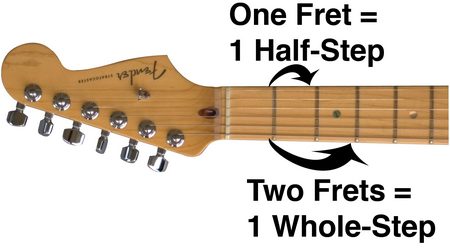 |
Applying these concepts, you could built a major tetrachord beginning from a C note as follows:
C D E F
W W h |- Major tetrachord -|
Building Major Tetrachords Into Major Scales
Once you understand how to construct a major tetrachord, it's a simple matter to build any major chord you like. Simply:
- Build a major tetrachord beginning with the root (sometimes called the tonic) of the major chord you're building...
- Add one whole-step note...
- Build a second major tetrachord, beginning at the whole-step note from step 2.
- Join the two major tetrachords together.
For example, suppose you wanted to build the C-Major scale. C is the root, or tonic note, that will begin the first tetrachord. We've already built this first tonic, in the example at the end of the Quick Review. It looks like this:
C D E F
W W h
|-tetrachord 1-|
The second step says we need to add a note that is a whole-step away from the last note of the first tetrachord. Since the first major tetrachord ended on F, we can easily calculate that the next whole-step note is G. (If we were looking for a half-step note, we would have stopped on F#.) Adding the G yields:
C D E F G
W W h W
|-tetrachord 1-| w-s (whole-step)
The third step is to add the next tetrachord (beginning with the whole-step note). The new major tetrachord is:
G A B C
W W h
|-tetrachord 2-|
Now we can join the two major tetrachords together.
C D E F G A B C
W W h W W W h
|-tetrachord 1-| w-s|-tetrachord 2-|
The C-Major Scale
This same method works for constructing any major scale. Here are two more examples, G Major and E Major.
G A B C D E F# G
W W h W W W h
|-tetrachord 1-| w-s|-tetrachord 2-|
The G-Major Scale
E F# G# A B C# D# E
W W h W W W h
|-tetrachord 1-| w-s|-tetrachord 2-|
The E-Major Scale
If you follow the four step method, you can construct any major scale.
Playing A Major Scale Up The Fretboard
It might make more sense to play one of the major scales on a single string before trying to play it across the fretboard.
Let's use the E-Major scale, since it helps us learn more notes on the fretboard (there are two E strings, with the same note names, though the notes differ in pitch) and because playing an outside string is easier for beginners than an inside string.
The illustration below uses the lower-E string, but you can play the high E if it's more comfortable for you.
The E-Major scale, as seen in the tetrachord construction, above consists of the notes E F# G# A B C# and D#. Most people expect you to complete the scale by ending on the note one octave higher than the first note of the scale (in this case, E).
The first note of the scale, E is played by plucking the open string. The next note (F#) is a whole-step, or two frets, above this. Simply continue two-frets, then one-fret, then two, two, two, and finally, one-fret to end on the next E at the twelfth fret.
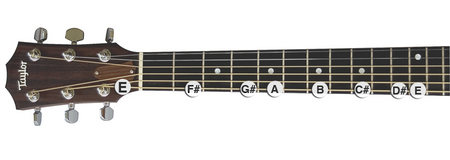 |
This is a great way to start, especially to visualize what a scale looks like on the guitar. But, it's not how most people play them. If you wish to play with speed, and without moving your hand all the way up and down the neck, you need to learn how to play a major scale across the fretboard. That's what I'll cover next.
Playing A Major Scale Across The Fretboard
There are many ways to play the E-Major scale, or nearly any scale, across the fretboard. Let's examine that for just a moment before I show you how to play it.
When you want to play a scale, step one is to find your starting note (in this case an E-note). The same note name appears many places on the guitar fretboard, though they usually produce different pitches. You can choose any of the E-notes in the illustration below, as long as it has another E-note above it (in pitch). I say 'above' because we're going to play UP the scale first.
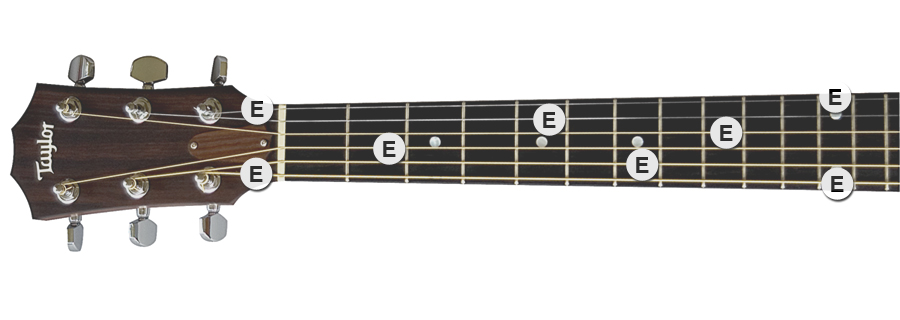 |
I'll show you two ways to play the E-Major scale across the fretboard. The first example will use open strings, beginning at the low-E open string. It looks like the following illustration. You begin by playing the open E-string to sound the root note of the scale (shown in yellow) then playing the other notes in sequential order. Note: I've widened the fretboard to make the note names easier to read.
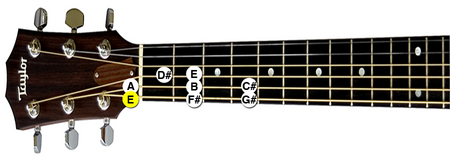 |
The next example of playing across the fretboard begins on the E-note of the D string. Play this version by following this illustration:
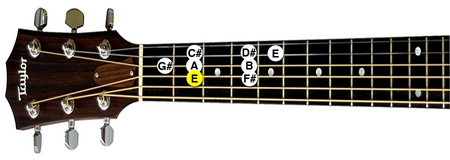 |
One final comment: To play this version of the E-Major scale your fretboard hand begins in what's known as first-position then slides up to second-position. First-position simply means that your index finger naturally falls across the first fret. To play the final three notes, it must slide up to second-position so you're prepared to reach the final E note. The slide is required because the B string is tuned a perfect-third above the lower G-string, but all other strings are tuned a perfect-fourth above the lower string. For more discussion of this, see An Important Oddity Of The Guitar Fretboard.
Next, read about Minor Scales or how to play the C-Major Scale in Second Position.


